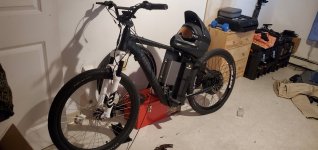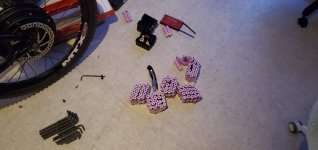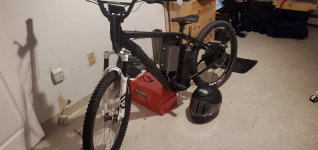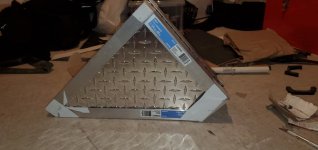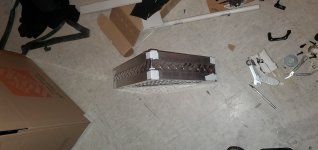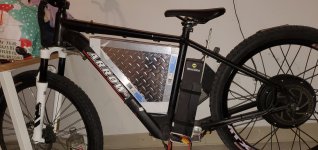webosplash
10 mW
- Joined
- Feb 14, 2021
- Messages
- 22
I bought a 5kw kit off of aliexpress(one of the QS models). It came with the 80 amp controller. Claims can be used with a variety of voltages from 48 to 72. Currently i am powering it with a 20s 3p battery comprised of 21700 40t cells with an 80 amp bms.
So i have some questions

1. Is this battery to small? am I damaging my cells?(I ride a fair amount on it around 30 to 40 mph( hit speed and cruise) it gets me about 10 miles if I'm riding like I'm driving bike weighs around 75 lbs I think I weigh 150.
2. I have a pack that I opened with 100 35e cells and plan to add another 100 for a 20s 10p 72vX35ah to fit into the triangle and move my controlled to the back. would this be a better or worse option?
3. If I took those 100 cells and made a 20s 5p and a 60 amp bms would this be unsafe as i have an 80a controller?
4.Does battery amp discharge stack? (20s 10p at 8a discharge per cell would be a flat 80 amps?)
5.Does charging amperage stack as well? (1 cell in a pack charges at 1a so 10 amps would be max in a 10p)
6. If I use those 100 cells to make to make a 20s 5p and slap a 60 amp bms on it will that be ok and safe?
7. Any suggestions or advice.
The ride is already very comfortable and fast (I've hit 55 on a slight down) but i need to desperately need to increase my range to as close to 50mi. as I can, and move at speed relative to an automobile
So i have some questions
1. Is this battery to small? am I damaging my cells?(I ride a fair amount on it around 30 to 40 mph( hit speed and cruise) it gets me about 10 miles if I'm riding like I'm driving bike weighs around 75 lbs I think I weigh 150.
2. I have a pack that I opened with 100 35e cells and plan to add another 100 for a 20s 10p 72vX35ah to fit into the triangle and move my controlled to the back. would this be a better or worse option?
3. If I took those 100 cells and made a 20s 5p and a 60 amp bms would this be unsafe as i have an 80a controller?
4.Does battery amp discharge stack? (20s 10p at 8a discharge per cell would be a flat 80 amps?)
5.Does charging amperage stack as well? (1 cell in a pack charges at 1a so 10 amps would be max in a 10p)
6. If I use those 100 cells to make to make a 20s 5p and slap a 60 amp bms on it will that be ok and safe?
7. Any suggestions or advice.
The ride is already very comfortable and fast (I've hit 55 on a slight down) but i need to desperately need to increase my range to as close to 50mi. as I can, and move at speed relative to an automobile


